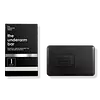What's inside
What's inside
 Key Ingredients
Key Ingredients

 Benefits
Benefits

 Concerns
Concerns

 Ingredients Side-by-side
Ingredients Side-by-side

Sodium Palmate
CleansingSodium Palm Kernelate
CleansingWater
Skin ConditioningGlycerin
HumectantSodium Chloride
MaskingCoconut Acid
CleansingCharcoal Powder
AbrasiveMethyl Salicylate
PerfumingMentha Viridis Leaf Oil
AstringentMenthol
MaskingRosmarinus Officinalis Leaf Oil
MaskingSodium Gluconate
Skin ConditioningCocos Nucifera Oil
MaskingVinegar
Butyrospermum Parkii Butter
Skin ConditioningPentasodium Pentetate
Tetrasodium Etidronate
Emulsion StabilisingCitric Acid
BufferingSodium Palmate, Sodium Palm Kernelate, Water, Glycerin, Sodium Chloride, Coconut Acid, Charcoal Powder, Methyl Salicylate, Mentha Viridis Leaf Oil, Menthol, Rosmarinus Officinalis Leaf Oil, Sodium Gluconate, Cocos Nucifera Oil, Vinegar, Butyrospermum Parkii Butter, Pentasodium Pentetate, Tetrasodium Etidronate, Citric Acid
Sodium Palmate
CleansingSodium Cocoate
CleansingWater
Skin ConditioningGlycerin
HumectantCharcoal Powder
AbrasiveCarbon
Cannabis Sativa Seed Oil
EmollientMentha Arvensis Leaf Oil
MaskingMentha Viridis Leaf Oil
AstringentCinnamomum Camphora Bark Oil
MaskingEucalyptus Globulus Leaf Oil
PerfumingRosmarinus Officinalis Leaf Oil
MaskingMentha Piperita Oil
MaskingSodium Chloride
MaskingSodium Gluconate
Skin ConditioningTetrasodium Glutamate Diacetate
Sodium Palmate, Sodium Cocoate, Water, Glycerin, Charcoal Powder, Carbon, Cannabis Sativa Seed Oil, Mentha Arvensis Leaf Oil, Mentha Viridis Leaf Oil, Cinnamomum Camphora Bark Oil, Eucalyptus Globulus Leaf Oil, Rosmarinus Officinalis Leaf Oil, Mentha Piperita Oil, Sodium Chloride, Sodium Gluconate, Tetrasodium Glutamate Diacetate
Ingredients Explained
These ingredients are found in both products.
Ingredients higher up in an ingredient list are typically present in a larger amount.
Charcoal powder comes from grounded charcoal. Charcoal can originate from peat, bamboo, coal, wood, coconut shell, or petroleum.
This ingredient has absorbent properties, making it great at absorbing oil.
Glycerin is already naturally found in your skin. It helps moisturize and protect your skin.
A study from 2016 found glycerin to be more effective as a humectant than AHAs and hyaluronic acid.
As a humectant, it helps the skin stay hydrated by pulling moisture to your skin. The low molecular weight of glycerin allows it to pull moisture into the deeper layers of your skin.
Hydrated skin improves your skin barrier; Your skin barrier helps protect against irritants and bacteria.
Glycerin has also been found to have antimicrobial and antiviral properties. Due to these properties, glycerin is often used in wound and burn treatments.
In cosmetics, glycerin is usually derived from plants such as soybean or palm. However, it can also be sourced from animals, such as tallow or animal fat.
This ingredient is organic, colorless, odorless, and non-toxic.
Glycerin is the name for this ingredient in American English. British English uses Glycerol/Glycerine.
Learn more about GlycerinRosmarinus Officinalis Leaf Oil is oil expressed from the leaves of the rosemary plant.
Rosemary Leaf Oil is a fragrance and helps give your product a scent. If you are sensitive to irritating fragrances, this one contains camphor. Camphor has been found to irritate skin.
This oil also contains antioxidant and antimicrobial properties. As an antioxidant, it may protect you skin against damage. This can help slow down the signs of aging.
Learn more about Rosmarinus Officinalis Leaf OilChances are, you eat sodium chloride every day. Sodium Chloride is also known as table salt.
This ingredient has many purposes in skincare: thickener, emulsifier, and exfoliator.
You'll most likely find this ingredient in cleansers where it is used to create a gel-like texture. As an emulsifier, it also prevents ingredients from separating.
There is much debate on whether this ingredient is comedogenic. The short answer - comedogenic ratings don't tell the whole story. Learn more about comegodenic ratings here.
The concensus about this ingredient causing acne seems to be divided. Research is needed to understand if this ingredient does cause acne.
Scrubs may use salt as the primary exfoliating ingredient.
Learn more about Sodium ChlorideThis is the synthetic salt of gluconic acid, a form of PHA and mild exfoliant.
It is mainly used to stabilize oil and butter formulations from going bad. Sodium gluconate is a humectant, pH regulator, and chelating agent.
Chelating agents help neutralize unwanted metals from affecting the formulation.
Sodium gluconate is water-soluble.
Learn more about Sodium GluconateSodium Palmate is a surfactant and used to saponify fatty acids. It can be derived from palm oil or synthetically created.
As a surfactant, it helps lift dirt and oil off the skin to be cleansed.
Sodium Palmate is also used during the soap-making process to saponify fatty acids. This helps soap creates bubbles without leaving residue on the skin.
This ingredient is sometimes called saponified palm oil.
Learn more about Sodium PalmateWater. It's the most common cosmetic ingredient of all. You'll usually see it at the top of ingredient lists, meaning that it makes up the largest part of the product.
So why is it so popular? Water most often acts as a solvent - this means that it helps dissolve other ingredients into the formulation.
You'll also recognize water as that liquid we all need to stay alive. If you see this, drink a glass of water. Stay hydrated!
Learn more about Water